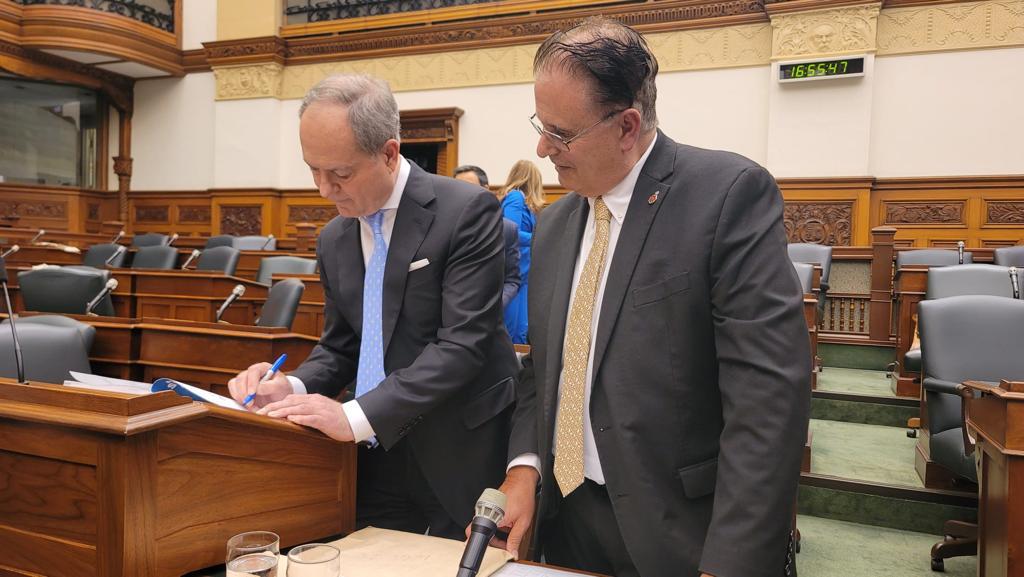Building a Strong Ontario
MISSISSAUGA — Minister of Finance Peter Bethlenfalvy has released Ontario’s 2023 Budget: Building a Strong Ontario. It is a plan that navigates ongoing global economic uncertainty with a responsible, targeted approach to help people and businesses today while laying a strong fiscal foundation for future generations.

“Ontario’s economy remains resilient, but the road ahead continues to be uncertain,” said Minister Bethlenfalvy. “Our government has the right plan to navigate these challenges. We are building Ontario so we can have a strong economy for the future and the infrastructure needed to support growth across the province.”
The government’s plan is taking significant actions to drive growth by lowering costs, getting key infrastructure projects built faster, and attracting more jobs and investment to help businesses, families and workers.
Highlights include:
- Implementing the most ambitious plan for hospital expansion in Ontario’s history, investing over $48 billion over the next 10 years in hospital infrastructure, including the complete reconstruction of the Mississauga Hospital.
- Continuing to relieve gridlock, create jobs and connect communities by investing $70.5 billion over the next 10 years for transit, including the completion of work on the Hazel McCallion Light Rail Transit Line on Hurontario.
- $27.9 billion to support the planning and construction of highway expansion and rehabilitation, including the building of Highway 413 – a new 400-series highway and transportation corridor across Peel, Halton, and York regions.
- Launching the new Ontario Made Manufacturing Investment Tax Credit, which would provide a 10 per cent refundable Corporate Income Tax credit to help local manufacturers lower their costs, invest in workers, innovate and become more competitive.
- Attracting over $16 billion in investments by global automakers and suppliers of EV batteries and battery materials to position Ontario as a global leader on the EV supply chain.
- Providing $224 million in 2023–24 for a new capital stream of the Skills Development Fund to leverage private-sector expertise and expand training centres, including union training halls to provide more accessible, flexible training opportunities for workers.
By working for workers, keeping costs down and providing better services, everyone will have an opportunity to take part in and benefit from Ontario’s plan.
Highlights include:
- Eliminating double fares for most local transit services in the Greater Golden Horseshoe when commuters also use GO Transit services.
- Providing financial support to more seniors by proposing changes to expand the Guaranteed Annual Income System (GAINS) program, starting in July 2024, to see 100,000 additional seniors be eligible for the program and the benefit adjusted annually to inflation.
- Investing in supportive housing with an additional $202 million each year in the Homelessness Prevention Program and Indigenous Supportive Housing Program to help those experiencing or at risk of homelessness, struggling with mental health and substance use, those escaping intimate partner violence, and support the community organizations delivering supportive housing.
- Helping more Ontario students becoming doctors by investing an additional $33 million over three years to add 100 undergraduate seats beginning in 2023, as well as 154 postgraduate medical training seats to prioritize Ontario residents trained at home and abroad beginning in 2024 and going forward. Ontario residents will also continue to be prioritized for undergraduate spots at medical schools in the province.
- Starting in fall 2023, expanding the program to allow pharmacists to prescribe over-the-counter medication for more common ailments, including mild to moderate acne, canker sores, diaper dermatitis, yeast infection, pinworms and threadworms, and nausea and vomiting in pregnancy.
- Providing an additional $425 million over three years to connect more people to mental health and addictions services, including a five per cent increase in the base funding of community-based mental health and addictions services providers funded by the Ministry of Health.
“As Parliamentary Assistant to the President of the Treasury Board, it was a great honour to work to ensure that the 2023 Ontario Budget offers responsible and targeted support for people and businesses,” said Rudy Cuzzetto, MPP for Mississauga—Lakeshore, “while also building a solid fiscal foundation for a stronger Ontario, amidst the current global challenges and uncertainty.”
The government is also providing an update on Ontario’s economic and fiscal outlook, with a plan that will balance the budget in 2024-25, three years earlier than forecast in the last Budget.
QUICK FACTS
- Ontario’s 2022–23 deficit is projected to be $2.2 billion — $17.7 billion lower than the outlook published in the 2022 Budget and $4.4 billion lower than the outlook published in the 2022–23 Third Quarter Finances.
- The government is projecting a deficit of $1.3 billion in 2023–24 and is on track to post a surplus of $0.2 billion in 2024–25, three years earlier than forecasted in the 2022 Budget. The government is also projecting a surplus of $4.4 billion in 2025–26. While this is a positive update, significant economic and geopolitical uncertainty persists.
- Ontario’s real GDP grew by an estimated 3.7 per cent in 2022 and is projected to increase by 0.2 per cent in 2023, 1.3 per cent in 2024, 2.5 per cent in 2025 and 2.4 per cent in 2026. For the purposes of prudent fiscal planning, these projections are slightly below the average of private-sector forecasts.
- The net debt-to-GDP ratio is projected to be 37.8 per cent in 2022-23 – the lowest level since 2011–12. Over the medium-term outlook, Ontario’s net debt-to-GDP ratio is now forecast to be 37.8 per cent in 2023-24, 37.7 per cent in 2024–25, and declining to 36.9 per cent in 2025–26.
ADDITIONAL RESOURCES